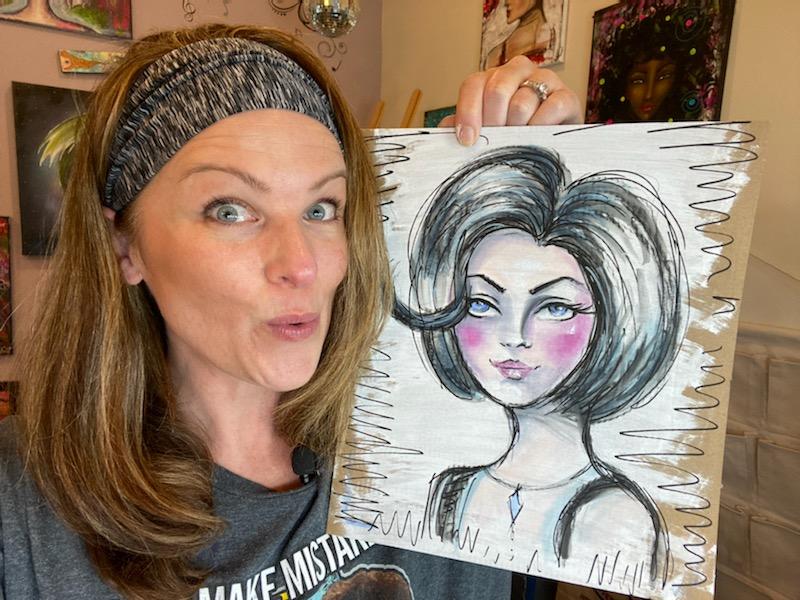
Robert Draws – Mixed Media Drawing is a technique that combines various materials and methods to create unique artworks. By blending different media, artists can express their creativity in ways that would be impossible with just one medium. This approach opens endless possibilities, allowing for both traditional and modern techniques to shine. From charcoal to watercolor, mixed media embraces diversity in artistic expression.
Mixed media drawing involves using two or more materials in a single piece of artwork. For example, an artist may use pencil for outlines, then add watercolor for color, and finish with ink for details. The combination of different media results in more texture, depth, and contrast than traditional methods.
Unlike using just one medium, this method encourages creativity and experimentation. Artists can layer different materials to achieve various effects, creating artwork that is both visually interesting and full of energy. By using unconventional tools or materials, such as fabric or sand, artists push the boundaries of what drawing can be.
“Read about: Exploring the Impact of Light and Shadow in Artistic Expression”
Creating a mixed media drawing requires careful planning and a bit of experimentation. Artists often start by selecting the materials they wish to use. These might include graphite, ink, markers, pastels, or even non-art materials like tissue paper or fabric. After deciding on materials, the artist begins by drawing the basic composition.
Once the foundation is laid, the artist can add layers of other media. For example, after creating a pencil sketch, watercolor can be applied for subtle color changes. Next, ink might be added for sharp contrasts or details. Each layer works with the previous ones to enhance the overall effect.
Layering techniques are essential in mixed media drawing. Artists often work from light to dark, allowing the initial layer to shine through the others. This can create depth, highlights, and shadows that wouldn’t be achievable with a single medium. The choice of which material to add next depends on the desired texture, color, and effect.
One of the most exciting aspects of mixed media drawing is the wide range of materials available. Artists can choose from traditional tools, like pencils and charcoal, to more unconventional items, such as fabric, buttons, or newspaper clippings. The key is to experiment and discover which materials complement each other.
Each material offers its own distinct texture and effect. For instance, charcoal provides rich, deep tones and a soft texture. Watercolors offer a fluid, translucent quality, while ink creates sharp contrasts and detailed lines. By combining these materials, artists can produce effects that are impossible with just one medium.
Incorporating found objects or textured materials, like cloth or paper, can add unexpected dimensions to a drawing. These elements may introduce a sense of tactile richness, giving the artwork a unique, personal touch.
When working with mixed media, there are several techniques that can enhance the final result. One such technique is layering. Layering materials allows the artist to build complexity and depth. For instance, an artist might start with pencil sketches, then use watercolor for a soft wash of color, and finish with ink to create bold outlines.
Another important technique is collage. By gluing materials like fabric or magazine clippings to a drawing, an artist can add a three-dimensional effect. This can make the artwork feel more alive and textured. Collage also introduces elements of surprise, as the artist can choose materials that are unusual or unexpected.
In addition to collage, artists can experiment with mark-making. By using brushes, sponges, or even their hands, artists can create expressive marks that add emotion and movement to the piece. This technique is perfect for adding energy and spontaneity to the drawing.
“Read more: The Role of Painting in Cultural and Political Movements”
Mixed media drawing offers numerous benefits. One of the most notable is the ability to create dynamic and complex works of art. By using various media, an artist can create texture, contrast, and depth, which enhances the visual impact of the piece.
Another advantage is the freedom to experiment. Since mixed media drawing is not bound by traditional rules, artists are encouraged to try new techniques and materials. This can lead to more innovative and personal artwork. Mixed media also allows for a greater sense of self-expression, as artists can combine elements that reflect their unique vision.
The versatility of mixed media also means it can be used to communicate a wide range of emotions and themes. Artists can adjust the materials and techniques to suit the mood they wish to convey, whether it’s the softness of watercolors or the boldness of ink.
Mixed media drawing is a wonderful way to explore creativity and push the boundaries of traditional art. It offers artists a chance to experiment with materials and techniques that go beyond the typical pencil or paint. By combining different media, artists can create pieces that are rich in texture, contrast, and meaning. This approach encourages innovation and allows for endless possibilities in the world of art.